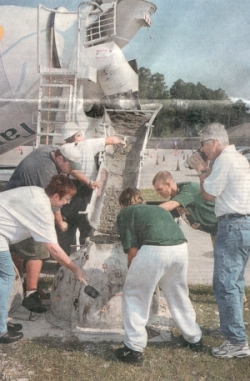 Mandarin students
Mandarin studentscontinue reef plan
By Dan Scanlan
Staff writer
The sounds echoing off the back walls of Mandarin High School Friday morning had the feel of a drum festival - thump, thump, thump ad finitum, with an occasional swoosh counterpoint.
It wasn't music, but people hammering sides of fiberglass molds from which will arise reef balls: hollow, gumdrop-shaped concrete balls used to jump-start the Charles H. Kirbo Memorial Reef reef on the Atlantic Ocean's sandy bottom.
Students from Alex Water's marine biology class have been making some of the artificial reef for the past year. But Thursday, volunteers from the Bank of America helped funnel concrete slurry into the R2-D2-shaped molds from a Tarmac concrete truck.
"Watch out for the splats," 19-year-old student Dan Hardie said as he hammered.
Waters is the project coordinator for the artificial reef project that saw 500 reef balls dropped off the coast June 3 to bring the bottom there to life. He had no outside help to mold the 15 balls the school made for the reef last year, but then Team Bank of America offered to help.
"I am doing it because I am interested in the ocean and want to preserve it for future generations, and this is a good project," said one of the three volunteers, Helen Preece. "I wish I could scratch my name in the inside so everyone would know that I worked on it. These things will draw bigger and better fish."
"This is a first, and I think it's nice. It shows there is some additional support in the community," Waters added. "Now we have some people who are involved hands-on who will hopefully be able to spread the word and let people know about the project."
Bradenton diver Todd Barber came up with the idea in 1993 of using concrete balls filled with holes, to lure fish, plants and crustaceans to underwater sites. Since then, Reef Ball Development Group has helped make 100,000 balls ranging from 35 pounds to a 4,000-pound "ultra ball" in more than 200 artificial reef projects worldwide.
The Kirbo memorial reef will be the company's largest when all 1,000 balls are dropped in the ocean between St. most of them at an old warehouse downtown, while Waters' marine biology students made . 15 at Mandarin High School, with 30 more to come this year. The $85,000 project honors an Atlanta attorney involved in the preservation of the natural environment.
Making the balls is hard work, as volunteers scraped excess concrete off the five molds, then pounded their sides to make sure the concrete set, avoiding grainy slurry dribbling from the truck.
"It looks like a mud bath," said truck driver Dennis Personette.
But thanks to their work and others, the artificial reef is thriving, said Waters.
"Within a year, it should be mature with established populations offish. If you dive, you will find certain species like snapper and grouper."
Hardie said he can't wait to see his handiwork in person this spring.
"My teacher said there is already life down there, so I want to see how they look," said the certified diver. "This is physical work. It hurts your hand as you hammer them, and you are out in the sun. But it is fun."
The next batch of about 200 balls should be dropped in late spring.